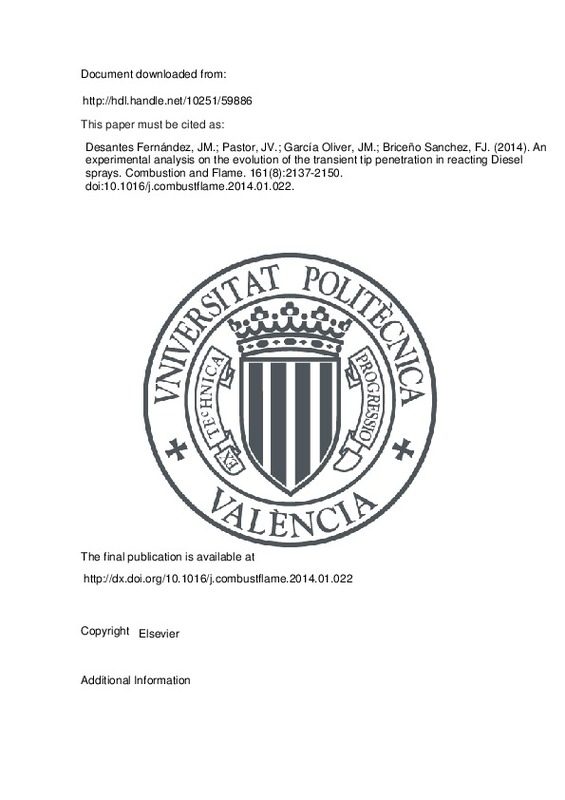JavaScript is disabled for your browser. Some features of this site may not work without it.
Buscar en RiuNet
Listar
Mi cuenta
Estadísticas
Ayuda RiuNet
Admin. UPV
An experimental analysis on the evolution of the transient tip penetration in reacting Diesel sprays
Mostrar el registro sencillo del ítem
Ficheros en el ítem
| dc.contributor.author | Desantes Fernández, José Mª
|
es_ES |
| dc.contributor.author | Pastor, José V.
|
es_ES |
| dc.contributor.author | García Oliver, José María
|
es_ES |
| dc.contributor.author | Briceño Sánchez, Francisco Javier
|
es_ES |
| dc.date.accessioned | 2016-01-14T13:43:16Z | |
| dc.date.available | 2016-01-14T13:43:16Z | |
| dc.date.issued | 2014-08 | |
| dc.identifier.issn | 0010-2180 | |
| dc.identifier.uri | http://hdl.handle.net/10251/59886 | |
| dc.description.abstract | Schlieren imaging has helped deeply characterize the behavior of Diesel spray when injected into an oxygen-free ambient. However, when considering the transient penetration of the reacting spray after autoignition, i.e. the Diesel flame, few studies have been found in literature. Differences among optical setups as well as among experimental conditions have not allowed clear conclusions to be drawn on this issue. Furthermore, soot radiation may have a strong effect on the image quality, which cannot be neglected. The present paper reports an investigation on the transient evolution of Diesel flame based upon schlieren imaging. Experimental conditions have spanned values of injection pressure, ambient temperature and density for typical Diesel engine conditions. An optimized optical setup has been used, which makes it possible to obtain results without soot interference. Based on observations for a long injection event (4 ms Energizing Time), the analysis has resorted to extensive comparison of inert and reacting sprays parameters, which have made it possible to define different phases after autoignition. Shortly after autoignition, axial and radial expansion of the spray have been observed in terms of tip penetration and radial cone angle. After that, during a stabilization phase, the reacting spray penetrates at a similar rate as the inert one. Later, the reacting spray undergoes an acceleration period, where it penetrates at a faster rate than the inert one. Finally, the flame enters a quasi-steady penetration phase, where the ratio of reacting and inert penetration stabilizes at a nearly constant value. The duration of the reacting spray penetration stages shows modifications when varying engine parameters such as air temperature, air density, injection pressure, and nozzle diameter. However, the proportionality between reacting and inert penetration has been observed to depend mainly on temperature, in agreement with observed reductions in entrainment when shifting from inert to reacting conditions. (C) 2014 The Combustion Institute. Published by Elsevier Inc. All rights reserved. | es_ES |
| dc.description.sponsorship | This work was partially funded by the Spanish Ministry of Science and Technology through the "EFFICIENT AND CLEAN COMBUSTION IN COMPRESSION IGNITION ENGINES USING THE DUAL-FUEL CONCEPT" Project (TRA2011-26359). Mr. Francisco J. Briceno wishes to acknowledge financial support through a PhD studies Grant (AP2008-02231) also sponsored by the Spanish Ministry of Education and Science. Last, but not least, authors would like to express their gratitude to Jose Enrique del Rey for his enthusiasm, proactiveness and help during data acquisition. | en_EN |
| dc.language | Inglés | es_ES |
| dc.publisher | Elsevier | es_ES |
| dc.relation.ispartof | Combustion and Flame | es_ES |
| dc.rights | Reserva de todos los derechos | es_ES |
| dc.subject | Fuel–air mixing | es_ES |
| dc.subject | Diesel combustion | es_ES |
| dc.subject | Lift-Off Length | es_ES |
| dc.subject | Schlieren | es_ES |
| dc.subject | Reacting tip penetration | es_ES |
| dc.subject | Diffusion flames | es_ES |
| dc.subject.classification | MAQUINAS Y MOTORES TERMICOS | es_ES |
| dc.title | An experimental analysis on the evolution of the transient tip penetration in reacting Diesel sprays | es_ES |
| dc.type | Artículo | es_ES |
| dc.identifier.doi | 10.1016/j.combustflame.2014.01.022 | |
| dc.relation.projectID | info:eu-repo/grantAgreement/MICINN//TRA2011-26359/ES/COMBUSTION EFICIENTE Y LIMPIA EN MOTORES DE ENCENDIDO POR COMPRESION UTILIZANDO EL CONCEPTO DUAL-FUEL/ | es_ES |
| dc.relation.projectID | info:eu-repo/grantAgreement/MICINN//AP2008-02231/ES/AP2008-02231/ | es_ES |
| dc.rights.accessRights | Abierto | es_ES |
| dc.contributor.affiliation | Universitat Politècnica de València. Departamento de Máquinas y Motores Térmicos - Departament de Màquines i Motors Tèrmics | es_ES |
| dc.contributor.affiliation | Universitat Politècnica de València. Instituto Universitario CMT-Motores Térmicos - Institut Universitari CMT-Motors Tèrmics | es_ES |
| dc.description.bibliographicCitation | Desantes Fernández, JM.; Pastor, JV.; García Oliver, JM.; Briceño Sánchez, FJ. (2014). An experimental analysis on the evolution of the transient tip penetration in reacting Diesel sprays. Combustion and Flame. 161(8):2137-2150. https://doi.org/10.1016/j.combustflame.2014.01.022 | es_ES |
| dc.description.accrualMethod | S | es_ES |
| dc.relation.publisherversion | http://dx.doi.org/10.1016/j.combustflame.2014.01.022 | es_ES |
| dc.description.upvformatpinicio | 2137 | es_ES |
| dc.description.upvformatpfin | 2150 | es_ES |
| dc.type.version | info:eu-repo/semantics/publishedVersion | es_ES |
| dc.description.volume | 161 | es_ES |
| dc.description.issue | 8 | es_ES |
| dc.relation.senia | 271584 | es_ES |
| dc.contributor.funder | Ministerio de Ciencia e Innovación | es_ES |







![[Cerrado]](/themes/UPV/images/candado.png)

